2017-2018最新人教版初中初三九年级英语第五单元unit-5教案(24页)备课教案教学设计教学反思导学案
人教版九年级英语Unit-5-reading教学设计

人教版九年级英语Unit 5 reading教学设计Unit 5 What are the shirts made of? Section B 2a-2e【教材分析】本节课是人教版《Go for it》九年级第五单元的第四课时,课型为阅读课。
旨在培养学生阅读能力的同时介绍最具中国特色的传统艺术,如孔明灯、剪纸和泥塑,包括它们的制作工艺、制作原料和象征意义等。
通过本节课,还训练学生一个重要的阅读策略,即让学生了解文章结构的特点之一—先总体介绍,后细节描写。
【学情分析】九年级的学生已经有了一定的语言基础和阅读能力。
但很多学生缺乏阅读的兴趣和坚持下去的耐心,我们在教学中要设计不同形式和层次的任务,来培养他们的兴趣和语言、阅读能力。
学生对于本节课中所涉及的传统艺术较为熟悉,对于这些传统艺术的制作材料以及用途也不陌生。
本篇文章可以拓展学生的知识面,提升民族自豪高,对学生跨文化交际有潜移默化的作用【教学目标】语言能力:围绕中国传统艺术的话题,深入感知一般现在时的被动语态句型,通过阅读文章首段的大致介绍和插图,能够把握文章整体结构和段落大意。
能够运用一系列阅读技巧有效提高阅读技能,了解文章结构特点。
文化意识:能够通过对文章标题“Beauty in Common Things” 的思考,能够发现生活中更多的美好事物,重视中国传统或民间艺术,坚定文化自信心。
通过了解一些地方知名产品或传统艺术品的制作过程以及制作材料,感受中国文化和中国精神。
培养学生的民族自豪感及爱国主义精神。
思维品质:通过速读,扫读,跳读,课文复述等方式,增强对文章的理解和分析能力,提升思维能力的逻辑性,批判性和创新性。
学习能力:通过阅读有关中国传统艺术的文章,保持学习英语的兴趣,通过阅读策略的训练和学习,增强阅读理解能力。
【教学重难点】教学重点:1.本节课的重点词汇2.通过预测,快速浏览,以及提取细节信息的活动,学生能掌握文章结构的特点教学难点:掌握被动语态的用法和功能。
2017-2018最新人教版初中初三九年级英语第五单元unit-5 (1)(39页)备课教案教学设计教学反思导学案

了解一般现在时态被动语态的结构和用法;
一、导入(启发探究 3 分钟) T: Please take out your things on your desk. We use them every day, do you really know them? Questions: Teacher: Can you tell me what these things are made of? And where are they made ? Students: _____________________. ① The books are made of paper ② The paper is made from tree. 二、自学(自主探究 6 分钟) 【教学过程】 1、拼读、记忆单词 material n. 材料;原料 chopstick n.筷子 coin n. 硬币 fork n. 餐叉;叉子 blouse n.(女式)短上衣;衬衫 silver n. 银;银器 adj. 银色的 glass n. 玻璃 cotton n. 棉;棉花 steel /sti:l/ n. 钢;钢铁 2、用所给动词的正确形式填空,每空一词 1.The apples are sent (send) to the factory for processing. 2. We are all ready but Tom hasn’t packed (pack) his clothes yet. 3. The windows of the room are cleaned (clean)every day. 4. The best cotton is produced (produce) in Xing Jiang in China. 5. The song isn’t liked (not like) by most of us. 3. 快速阅读 1a 表格部分的内容。把物品和可能构成他们的材料匹配起 来。 (1 分钟) 4、核对检查答案,再次朗读、记忆单词。 三、交流(合作探究 10 分钟) 1.听录音一次,体会语音语调、句群停顿。(1 分钟) 2. 听第二遍录音,并完成课本上 1b 的听力任务。 (1 分钟) 3、再听录音一次,填空 Susan: Hi, Anita. I three shirts for 29 dollars yesterday! Anita: Oh, really? What are they of though? Sometimes the cheap 初中九年级初三英语全册
2017-2018最新人教版初中初三九年级英语第五单元unit5(3页)备课教案教学设计教学反思导学案

Unit5 What are the shirts made of ?第1课时Section A 1a-2d一、知识点1.词汇:1)单词:chopstick, coin, fork, blouse, silver, glass, cotton, steel,fair, environmental, grass, leaf, produce, widely, be known for, process,pack2)词组:be known for, environmental protection, a model plane, bemade of, be famous for, around China,3)句型:Is it made of silver? What is the painting made from? Whereis tea produced in China? It seems that many people and sent to many different countries and places around China.2.语法:一般现在时被动语态的结构:am/is/are+ done二、重难点1.词汇:1)单词:chopstick, steel, fair, environmental, leaf, produce2)词组:be known for, environmental protection, be made of,3)句型:Is it made of silver? What is the painting made from?2.语法:被动语态的结构:be done三、易混点、易错点1.词汇:be made of和be made from,be famous 和as be famous for2.句型:Where is tea produced ? How is tea prouced?3.语法:一般现在时被动语态的结构:am/is/are+ done第2课时Section A 3a-4c一、知识点1. 词汇:1)单词:product, pack, France, no matter, local, brand, avoid, handbag,mobile, everyday, boss, Germany, surface, material, traffic, postman, cap, glove2)词组:no matter what, buy…for…, a pair of…,everyday things, onthe last Friday of each month, traffic accidents2.句型:He found it interesting that so many products in the localshops were made in China. Tea is grown by people in Hangzhou.3.一般现在时被动语态的结构:am/is/are+ done二、重难点1.词汇:product, local, avoid, everyday, material, postman,2.句型:He found it interesting that so many products in the localshops were made in China. Tea is grown by people in Hangzhou.3.语法:一般现在时被动语态的结构:am/is/are+ done三、易混点、易错点1. 词汇:discover 和find2. 句型:主语+find/believe+it+adj.+that 引导的从句3. 一般现在时被动语态的结构:am/is/are+ done第3课时(Section B 1a-2b)一、知识点1.词汇:international, competitor, its, form, clay, celebration,ballon, paper cutting, scissors, lively, fairy, historical, heat, polish, complete2.句型:The international kite festival is held in April every year.3. 一般现在时被动语态的结构:am/is/are+ done二、重难点1. 词汇: celebration, paper cutting, lively, heat, polish, complete2.句型:It takes several weeks to complete everything.3. 一般现在时被动语态的结构:am/is/are+ done三、易混点、易错点1. 词汇:its 和it’s2. 句型:It takes several weeks to complete everything.3. 一般现在时被动语态的结构:am/is/are+ done第4课时(Section B 2b-3b)一、知识点1. 词汇:international, competitor, its, form, clay, celebration,ballon, paper cutting, scissors, lively, fairy, historical, heat, polish, complete2.句型:They are made of bamboo and covered with paper.3.语法:一般现在时被动语态的结构:am/is/are+ done二、重难点1. 词汇:its, form, celebration, lively, historical, complete2.句型:They are made of bamboo and covered with paper.3. 语法:一般现在时被动语态的结构:am/is/are+ done三、易混点、易错点1. 词汇:live和lively2. 句型:Today sky are used at festivals.3. 一般现在时被动语态的结构:am/is/are+ done第5课时(Self Check)一、知识点1.词汇:widely, process,avoid, traffic,its,lively,heat2.句型:What’s the model plane made of ?3. 语法:一般现在时被动语态的结构:am/is/are+ done二、重难点1. 词汇:widely, process,avoid, traffic,its,lively,heat2.句型:What’s the model plane made of ?3. 语法:一般现在时被动语态的结构:am/is/are+ done三、易混点、易错点1. 词汇:its,it 和it’s2. 句型:Some classic films were shown at that cinema last week.3. 语法:一般现在时被动语态的结构:am/is/are+ done本单元重点语法:1.一般现在时的被动语态:am/is/are + done2.被动语态强调动作的承受者,而不是执行者。
人教新目标英语九年级英语unit5(sectionA1a2d)教学设计

一、教学目标
(一)知识与技能
1.知识目标:通过本节课的学习,使学生掌握以下英语词汇和表达方式:illness(疾病)、symptom(症状)、medicine(药物)、cure(治愈)、recover(恢复)、sore throat(喉咙痛)、headache(头痛)、fever(发烧)、take one's temperature(量体温)、prescription(处方)、pharmacy(药店)等。同时,让学生学会使用一般过去时描述过去的疾病经历。
5.家长参与:请家长协助学生完成角色扮演视频作业,并在视频拍摄过程中关注学生的英语表达。家长可以为学生提供语言支持,同时了解孩子的学习情况。
1.对话编写:小组成员共同讨论,完成一段不少于10句话的就医对话。对话内容要贴近生活,符合实际情境。
2.角色扮演视频:视频时长不少于3分钟,包含医生、病人两个角色。注意口语表达的准确性,以及动作、表情的自然。
2.技能目标:培养学生运用英语进行就医咨询的能力,学会描述病情、询问药物及用法。通过小组讨论,提高学生的口语表达能力和听力理解能力。
(二)过程与方法
1.过程目标:通过情景教学,引导学生运用所学知识进行角色扮演,模拟就医场景,提高学生的实际应用能力。让学生在小组合作中,学会倾听、表达、沟通和协作。
2.方法目标:采用任务型教学法,设计丰富的课堂活动,如小组讨论、角色扮演、听力训练等,激发学生的学习兴趣,提高学生的参与度和积极性。
(四)课堂练习
1.听力训练:播放一段就医场景的听力材料,让学生回答相关问题,检测他们对词汇和语法的掌握程度。
2.口语表达:邀请学生上台展示角色扮演,其他学生认真聆听,并给予评价。教师关注学生的语言表达,及时纠正错误。
英语人教版九年级上册Unit5全单元教案
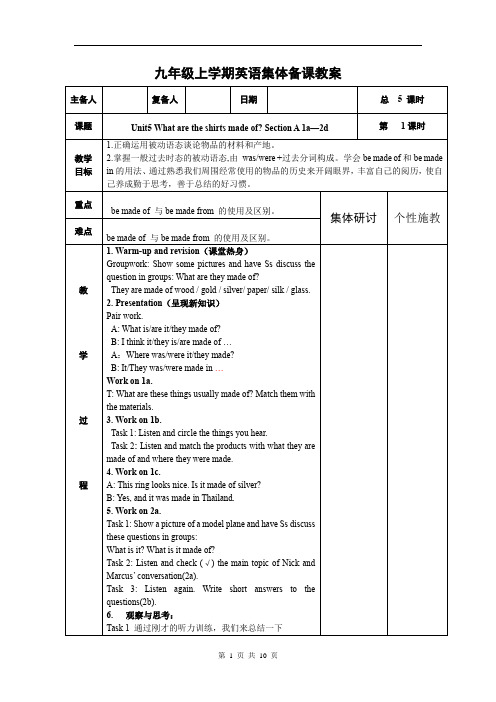
B: It/They was/were made in…
Work on 1a.
T: What are these things usually made of? Match them with the materials.
3.Work on 1b.
(2)Tea plants are grown on the sides of mountains......
10.小结。检测本课教学成果。
作
业
设
计
Homework:
介绍自己一样最感兴趣的物品,介绍制作者,何时制作的,有哪些材料做成,有何用途(be used for)等。
板
书
设
计
Section A1 (1a-2d)
Task 2:Listen and check (√) the main topic of Nick and Marcus’conversation(2a).
Task 3:Listen again. Write short answers to the questions(2b).
6.观察与思考:
Task1通过刚才的听力训练,我们来总结一下
Task2:Read the passage again and write what the words in bold refer to.
Task 3:仔细阅读文章,完成下列句子。
Kang Jian is a _____________ student from Shanghai.
People would buy a _______ in Japan, some beautiful ________ in France, or a ________ in Switzerland.
人教版九年级英语教师公开课使用教学设计方案第五单元
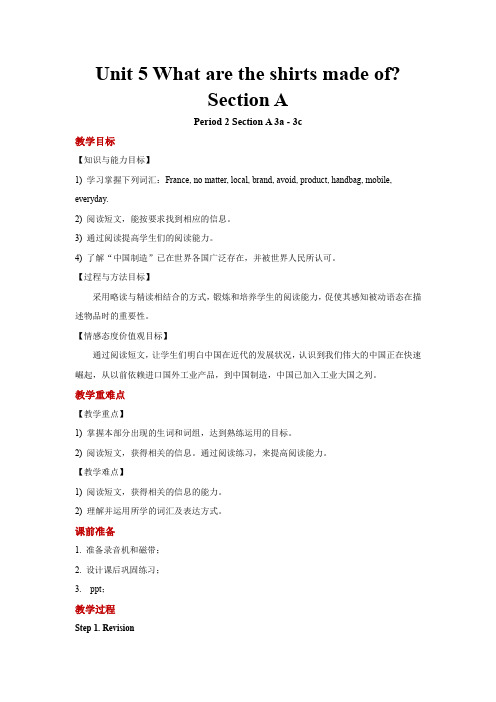
Unit 5 What are the shirts made of?Section APeriod 2 Section A 3a - 3c教学目标【知识与能力目标】1) 学习掌握下列词汇:France, no matter, local, brand, avoid, product, handbag, mobile, everyday.2) 阅读短文,能按要求找到相应的信息。
3) 通过阅读提高学生们的阅读能力。
4) 了解“中国制造”已在世界各国广泛存在,并被世界人民所认可。
【过程与方法目标】采用略读与精读相结合的方式,锻炼和培养学生的阅读能力,促使其感知被动语态在描述物品时的重要性。
【情感态度价值观目标】通过阅读短文,让学生们明白中国在近代的发展状况,认识到我们伟大的中国正在快速崛起,从以前依赖进口国外工业产品,到中国制造,中国已加入工业大国之列。
教学重难点【教学重点】1) 掌握本部分出现的生词和词组,达到熟练运用的目标。
2) 阅读短文,获得相关的信息。
通过阅读练习,来提高阅读能力。
【教学难点】1) 阅读短文,获得相关的信息的能力。
2) 理解并运用所学的词汇及表达方式。
课前准备1. 准备录音机和磁带;2. 设计课后巩固练习;3. ppt;教学过程Step 1. Revision1. Ask Ss to role-play the conversation in 2d.2. Check the homework. Let some Ss tell read their sentences.(1) This ring is made of silver.(2) This kind of paper is made from wood.(3) What is paint made from?(4) Hang Zhou is famous for tea.(5) As far as I know, tea plants are grown on the sides of the mountains.Step 2. PresentationLearn some new words.product n.产品,制品France 法国French adj.法国的,法国人的n.法语,法国人handbag n. 小手提包Step 3. Warm upRead the title of the passage and talk about the following questions.1. Where is the tourist?2. Does he want to buy Chinese products or American products?3. Is it easy for him to buy American products? Why?Step 4. Reading1. T: As we know, there are so many things made in China in England. What about in America and other countries in the world? Now let’s read the passage of 3a. First, read quickly and find the answer to this question:Ss read the article quickly and try to answer the questions:2. Work on 3bAnswer the questions and learn some new words.3. Work on 3cStep 5. Post readingAsk Ss to fill in the blanks to complete the passage.Check the answers with the Ss.Step 6. Language points1. No matter what you may buy, you might think those products were made in those countries.无论你买什么, 你也许会认为那些产品一定就是那些国家制造的。
人教版九年级英语上册 Unit 5 教案设计
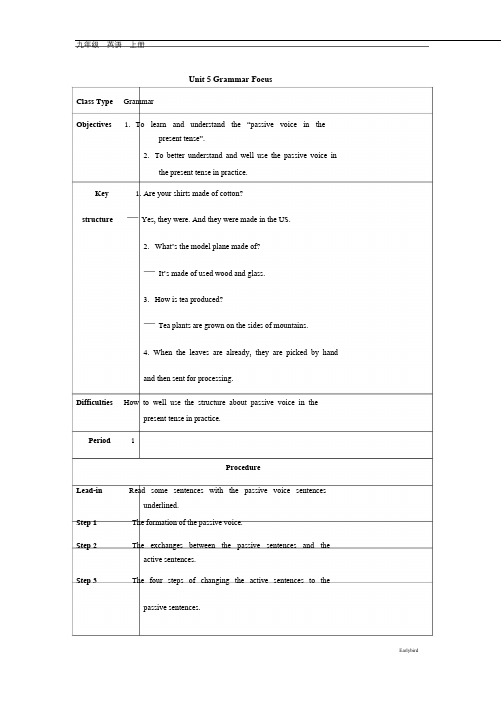
Unit 5 Grammar FocusClass Type GrammarObjectives 1. To learn and understand the “passive voice in thepresent tense”.2. To better understand and well use the passive voice inthe present tense in practice.Key 1. Are your shirts made of cotton?structure —Yes, they were. And they were made in the US.2. What’s the model plane made of?—It’s made of used wood and glass.3. How is tea produced?—Tea plants are grown on the sides of mountains.4. When the leaves are already, they are picked by handand then sent for processing.Difficulties How to well use the structure about passive voice in thepresent tense in practice.Period 1ProcedureLead-in Read some sentences with the passive voice sentencesunderlined.Step 1 The formation of the passive voice.Step 2 The exchanges between the passive sentences and theactive sentences.Step 3 The four steps of changing the active sentences to thepassive sentences.EarlybirdStep 4 Exercises.1. The exchanges of sentence structures.2. Complete the sentences with the correct words.3. Changing sentences based on the requests.4. Choosing the correct answers.Step 5 The basic sentence structures of the passive voice.1. Subject + be + p.p. + (by …).2. Subject + be + not + p.p. + (by …).3. Be + subject + p.p. + (by…)?4. 疑问词+ be + subject + p.p. + (by…)?Step 6 The using of the passive voice.Step 7 The special attentions about the process of exchangingactive voice to the passive voice.Step 8 Other attentions.Step 9 Pair works.Let Ss make conversations by using the sentences below.A: where is/are …?B: It is/They are … in ….Step 10 More exercises about the grammar focuses.Step 11 Activity 4a.Read and complete the sentences with the correct forms ofthe verbs in brackets.Step 12 Activity 4b.Ask Ss to rewrite the sentences by using the passive voice.Unit 5 Section A-1EarlybirdClass Type Listening, reading and speakingObjectives 3. To learn what materials the things were made of.4. To know what the things are made of and where theywere made.5. To practice talking about the conversations.Key 1. This ring looks nice. Is it made of silver?structure —Yes, and it was made in Thailand.2. What did you see at the art and science fair?—I saw…—What is it made of / from?6. Where is tea produced in China?7. Tea is good for both health and business.Difficulties How to better understand and express the materials and theplaces of these things.chopsticks, fork, blouse, silver, glass, cotton, steel, fair,grass, leaf, produce, widely, processVocabularybe known forPeriod 1ProcedureLead-in Guessing game.Show Ss some pictures and ask Ss to say the name of thesethings in English.Step 1 Discussion:What are these things usually made of?—It is made of …/ They are made of ….Step 2 Activity 1b.Let Ss listen a passage and then to match the products withwhat they were made of.EarlybirdStep 3 Listen again and ask Ss to answer some questionsaccording to passage in 1b.Step 4 Pair works. Make conversations.Show Ss some pictures and give some information, andthen to ask Ss to make conversation by using the sentencesin 1a.E.g. :A: This ring looks nice. Is it made of silver?B: Yes, and it was made in Thailand.Step 5 Activity 2a.Let Ss listen a conversation and check the main topic ofNick and Marcus’ conversation.Step 6 Activity 2b.Let Ss listen again and answer the questions following.Step 7 Pair works.Let Ss suppose that they have just visited a museum or anart fair. And then make conversations by using the sentencestructures in 2a and 2b as the model.Step 8 Activity 2d.Let Ss listen to the tape and ask them to answer thequestions.Step 9 Listen again and read the conversation in the textbook.Step 10 Pair works.Show Ss some pictures with some information and ask Ssto have a discussion.1. What is famous in your city?2. What is it made of?3. Make a conversation using 2d as a model.Step 11 Language points: explain the key words and phrases insection A-1.Step 12 More examples and exercises about the language points.EarlybirdUnit 5 Section A-2Class Type ReadingObjectives 8. To learn about the products in America.9. To know more about the products that made in China.Key 1. No matter what you may buy, you might think thosestructure products were made in those countries.2. He found it interesting that …3. Kang Jian thinks it’s great that China is so good atmaking these everyday things.Difficulties How to know the products showed in America but weremade in China.Product, France, local, avoid, handbag, mobile, everydayno matter, search forVocabularyPeriod 1ProcedureLead-in Revision.Give Ss some phrases and ask Ss to translate them.Step 1 Free talk.Give Ss some information and let them talk about thequestions:1. “If you take a trip abroad, what would you do?”.2. If you go to Switzerland, what would you buy?3. If you go to France, what would you buy?4. If you go to Japan, what would you buy?EarlybirdStep 2 Activity 3b.Let Ss read the passage about the American products andanswer the questions following.Step 3 Read the passage again and answer the questions accordingto the passage in 3a.Step 4 Activity 3c-1.Ask Ss to read the passage again and write what the wordsin bold refer to.Step 5 Free talk.Why are so many foreign firms moving to China?Step 6 Activity 3c-2.Read the passage again and write what the underlinedwords refer to.Step 7 Brainstorm.Show Ss some information about Chinese products.Step 8 Language points: explain the key words and phrases insection A-2.Step 9 More examples and exercises about the language points.Unit 5 Section B-1Class Type Listening and speaking.Objectives 1. To learn the information about kites.2. To learn and understand more information about kitesby listening.3. To practice talking about the conversation.Key 1. Some were painted with colorful…Earlybirdstructure 2. When did you go on vacation?—I went to an international kite festival.—That sounds interesting. What did you see there?Difficulties How to learn and better understand the information ofkites.boss, Germany, surface, material, traffic, postman, cap,glove, international, itsVocabulary fly a kite, be made of,Periods 1ProcedureLead-in Revision.1. Exercises about the exchanges of sentence structures.2. Complete the sentences with correct words.Step 1 Free talk.Show Ss some pictures and information of Weifang andask Ss to talk about the questions:1. Have you ever heard of Weifang, Shangdong province?2. What is it known as?Step 2 Discussion.Show Ss some pictures of kites and ask Ss to think and talkabout what the kites are made of according to the fact thatkite flying is popular with Chinese people.Step 3 Activity 1b.Let Ss listen to a conversation and circle the correctanswers.Step 4 Activity 1c.Let Ss listen again and then write L for Laura and Z forZheng Yun after these sentences.Step 5 Activity 1d.Let Ss listen the conversation again and fill in the blankswith the information they hear.Step 6 Pair works.Let Ss act as Laura and Zheng Yun to have the role-playEarlybirdconversations using the information as followed.e.g.:A: Where did you go on vacation?B: I went to an international kite festival.A: That sounds interesting. What did you see there?B: …Step 7 Free talk.Ask Ss to talk about a festival that they are familiar with.Step 8 Brainstorm (Learning More).1. Four main kinds of Chinese kites with vivid pictures.2. More information about Wei Fang and its kite museum.Step 9 Language points: explain the key words and phrases insection B-1.Step 10 Examples and exercises about the language points.Unit 5 Section B-2Class Type Reading and writingObjectives 1. To understand the passage about the special forms oftraditional Chinese arts.2. To discuss the art form in groups.3. To introduce a special product of art in your own city.My town is famous/ known for …Key… is famous in my town. structure… is/are made of/ from/ with/ by/ in …… is /are used for…… is special because …Difficulties How to know and understand more art forms in China.its, form, balloon, scissors, lively, heat, completeVocabularysuch as, turn into, at a high heat, send out, cover with, riseEarlybirdinto, put … onPeriods 1ProcedureLead-in Free talk.Show Ss some traditional folk or arts and ask Ss to talkabout what kind of traditional arts or folks they know intheir hometownStep 1 Activity 2b-1.Read the passage in 2b and answer the questions following.Step 2 Activity 2b-2.Let Ss read the passage again and complete the chart.Step 3 Show some pictures of learning habits, talk about are thosegood or bad, and give out your reasons.Step 4 Activity 2c.Read the passage quickly and answer the questionsaccording to the information in 2b.Step 5 Discussion.After reading the passage, ask Ss to think and talk aboutthe main parts that this passage can be divided into andgive the reasons.Step 6 Summary of writing orders and structures.Step 7 Specific analyses.Let Ss read paragraph 2, 3 and 4 to answer questions.Step 8 Activity 2d.Complete the sentences using the correct forms of thephrases in the box.Step 9 Free talk.Show Ss some pictures and ask Ss to talk about thequestions:1. Which art form do you think is the easiest? Which is themost difficult? Why?2. Which art form would you like to learn? Why?EarlybirdStep 10 Practice.According to the specific steps of cutting a butterfly, ask Ssto make it on their own and then show their works in class.Step 11 Pair works.Let Ss discuss about the special and famous things in theirhometown with their partner and take some notes.Step 12 Language points: explain the key words and phrases insection B-2.Step 13 More examples and exercises about the language points.Earlybird。
人教版新目标九年级英语Unit5第五单元全单元教案教学设计
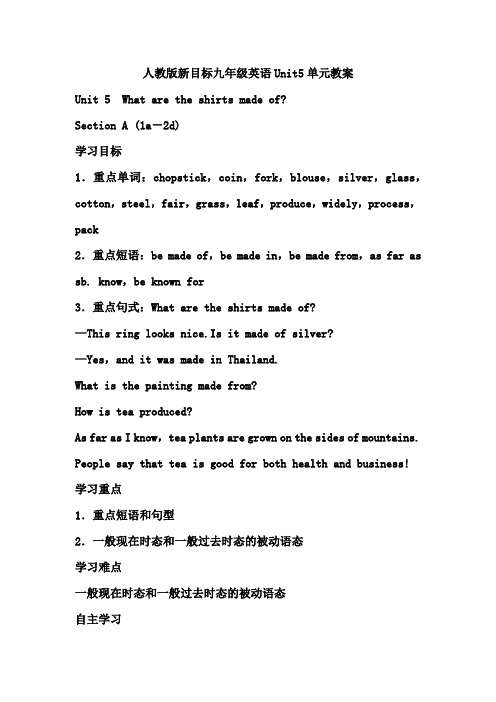
人教版新目标九年级英语Unit5单元教案Unit 5 What are the shirts made of?Section A (1a-2d)学习目标1.重点单词:chopstick,coin,fork,blouse,silver,glass,cotton,steel,fair,grass,leaf,produce,widely,process,pack2.重点短语:be made of,be made in,be made from,as far as sb. know,be known for3.重点句式:What are the shirts made of?—This ring looks nice.Is it made of silver?—Yes,and it was made in Thailand.What is the painting made from?How is tea produced?As far as I know,tea plants are grown on the sides of mountains. People say that tea is good for both health and business! 学习重点1.重点短语和句型2.一般现在时态和一般过去时态的被动语态学习难点一般现在时态和一般过去时态的被动语态自主学习一、预习课本P33-34新单词并背诵,完成下面的汉译英。
1.筷子________ 2.硬币________3.叉子________ 4.衬衫________5.银器________ 6.玻璃________7.棉花________ 8.钢铁________9.展览会________ 10.草地________11.叶子________ 12.生产________13.普遍地________ 14.加工________15.包装________二、认真预习1a-2d找出下列短语和句型。
人教版九年级英语上册Unit5教学设计

五、作业布置
针对本章节的学习内容,特布置以下作业:
1.词汇练习:请学生完成课后练习中的词汇填空题,巩固本节课所学的词汇和短语,如"adventure", "achieve", "conquer", "challenge"等。
要求:准确无误地完成填空,并在家长监督下进行复习。
2.针对提高阅读理解和写作水平的教学,采用以下方法:
(1)精选与单元主题相关的阅读材料,引导学生运用阅读策略,如预测、扫读、细读等,提高阅读效率。
(2)组织课堂讨论,让学生分享阅读心得,培养批判性思维和跨文化交际意识。
(3)结合写作任务,指导学生进行句子仿写、段落创编,提高写作水平。同时,关注学生的写作过程,给予个性化指导。
要求:故事内容丰富、结构清晰,注意句子间的逻辑关系。
5.口语练习:与家长或同学进行对话,分享自己在学习英语过程中的趣事,要求运用一般过去时态。
要求:注意发音准确,提高口语表达能力。
6.课后总结:请学生撰写一篇关于本节课学习心得的英文短文,内容包括对本节课知识点的掌握、学习过程中的困惑以及解决办法等。
2.语法练习:根据本节课学习的一般过去时态,完成课后练习中的语法填空题,强化对一般过去时态的掌握。
要求:仔细审题,确保句子时态正确,提高语法运用能力。
3.阅读理解:阅读课后提供的英文文章,回答相关问题,锻炼阅读理解能力。
要求:注重阅读策略的运用,如预测、扫读、细读等,提高阅读效率。
4.写作任务:根据本节课学习的知识点,编写一个小故事,要求运用一般过去时态和宾语从句、定语从句等语法知识点。
人教版九年级英语上册Unit5教学设计
人教新目标九年级英语Unit5单元教学设计

人教新目标九年级英语Unit5单元教学设计教案Unit 5 What are the shirts made of?Period 1 Section A 1a-2d【教材内容分析】本课是一节听说课。
主要谈论日常用品和制造该用品所需原材料以及生产地等,首先,通过谈论生活中常见物品(如杯子、课桌等)的制作原料来导入话题。
复习并呈现日常用品及原材料的相关词汇。
因本课的很多词汇与生活联系密切,所以很多物品可以通过实物进行展示,如chopsticks, fork,coin,blouse,glass,silk等。
在听说过程中,自然呈现出被动语态句式,让学生感知被动语态的结构及其表意功能。
借助听力材料,切入到再生资源和环保话题,对学生进行潜移默化的人文教育。
通过一个关于茶叶的对话,呈现被动语态在不同语境下更多真实运用的例句,加强学生对这一新语法项目的感性认识。
【学情分析】被动语态对于学生来说,这是在教材中首次接触。
但实际上,很多学生受母语的影响,对被动语态也有一定的了解。
通过给学生一定的情景,谈论日常用品的原材料和生产地,让他们体会被动语态的结构和表意功能。
在听说训练过程中,让学生通过自主和合作学习的方式进行句式结构的语言输入,并设计相应的任务,鼓励学生运用所学进行语言实践,并就原材料话题对学生进行生态环保方面的人文教育。
【学习目标】1.学生能识记本课表示日常用品的词汇:chopsticks,window,coin,stamp,fork,blouse等。
2.学生能识记表示原材料的词汇:wood,gold,silver,paper,silk,cotton,glass。
3.学生初步掌握被动语态的句式结构:A: What is the model plane made of?B:It’s made of used wood and glass.4.学生能够树立生态环保意识,简单了解中国的茶文化。
【学习重点】学会使用被动语态表达被动关系。
人教版九年级英语Unit5全英文教案新目标-人教新目标版九年级全册
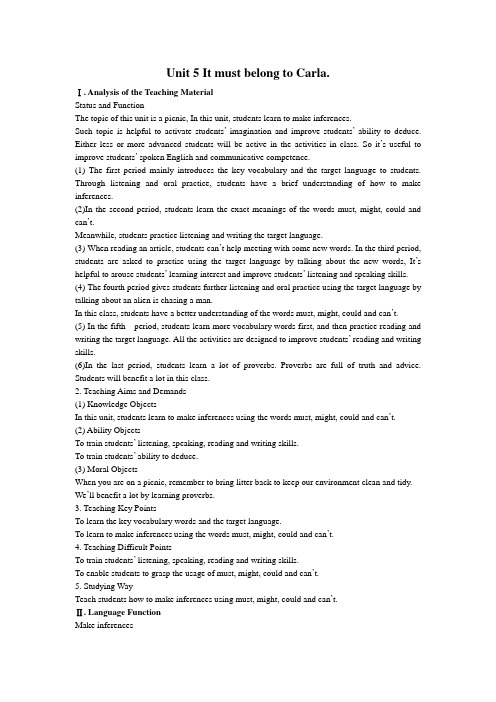
Unit 5 It must belong to Carla.Ⅰ. Analysis of the Teaching MaterialStatus and FunctionThe topic of this unit is a picnic, In this unit, students learn to make inferences.Such topic is helpful to activate students’imagination and improve students’ability to deduce. Either less or more advanced students will be active in the activities in class. So it’s useful to improve students’ spoken English and communicative competence.(1) The first period mainly introduces the key vocabulary and the target language to students. Through listening and oral practice, students have a brief understanding of how to make inferences.(2)In the second period, students learn the exact meanings of the words must, might, could and can’t.Meanwhile, students practice listening and writing the target language.(3) When reading an article, students can’t help meeting with some new words. In the third period, students are asked to practise using the target language by talking about the new words, It’s helpful to arouse students’ learning interest and improve students’ listening and speaking skills. (4) The fourth period gives students further listening and oral practice using the target language by talking about an alien is chasing a man.In this class, students have a better understanding of the words must, might, could and can’t. (5) In the fifth period, students learn more vocabulary words first, and then practice reading and writing the target language. All the activities are designed to improve students’ reading and writing skills.(6)In the last period, students learn a lot of proverbs. Proverbs are full of truth and advice. Students will benefit a lot in this class.2. Teaching Aims and Demands(1) Knowledge ObjectsIn this unit, students learn to make inferences using the words must, might, could and can’t. (2) Ability ObjectsTo train students’ listening, speaking, reading and writing skills.To train students’ ability to deduce.(3) Moral ObjectsWhen you are on a picnic, remember to bring litter back to keep our environment clean and tidy. We’ll benefit a lot by learning proverbs.3. Teaching Key PointsTo learn the key vocabulary words and the target language.To learn to make inferences using the words must, might, could and can’t.4. Teaching Difficult PointsTo train students’ listening, speaking, reading and writing skills.To enable students to grasp the usage of must, might, could and can’t.5. Studying WayTeach students how to make inferences using must, might, could and can’t.Ⅱ. Language FunctionMake inferencesⅢ. Target LanguageWhose volleyball is this?It must be Carla’s. She loves volleyball.It could be Ted’s.Ⅳ. Structuremust, might, could and can’tⅤ. Vocabularypicnic, chase, escape, belong to, toy car, plate’, mystery, appointment, worried, wake, neighbor, garbageⅥ. Recyclingsuit, land, volleyball, magazine, book, CD, bat, earring, T-shirt, UFO, whose, owner, exercise, dream, anxiousⅦ. Learning Strategies1. Sequencing2. DeducingⅧ. Teaching TimeSix periodsThe First PeriodI. Teaching Aims and Demands1. Knowledge Objects(1) Key V ocabularybelong, belong to, plate, author, toy, picnic(2)Target LanguageWhose book is this?It must be Mary’s. Wanda Wilbur is her favourite author.2. Ability Objects(1) Train students’ listening skill.(2) Train students’ communicative competence using the target language.3. Moral ObjectsWhen you are on a picnic, remember to bring litter back to keep our environment clean and tidy. Ⅱ.Teaching Key Points1. Key vocabulary2. Target languageⅢ.Teaching ProceduresStep I RevisionCheck homework. Invite different students to say the answers to the exercises on pages 12~14 of the workbook.Step Ⅱ1aThis activity introduces the key vocabulary.Write the key vocabulary words on the blackboard. Say the words one by one and have students repeat several times until they can read them fluently and accurately.Ask different students to explain in their own words the meanings of the words belong to, author and picnic.Belong means to be owned by somebody.An author is a writer of a book or a play.A picnic is a meal eaten out of doors.Then invite two students to draw a plate next to the word plate and a toy car next to toy.Focus attention on the picture. Have students point to each item and say its name. Call students attention to the chart with the headlines clothing. Funthings and kitchen things at the top. Invite different students to explain the meanings of the column heads.Say, Please look at the picture and write the things you see in the correct columns in the chart. Point out the sample answers. Get students to complete the task on their own. As they work, move around the room checking their progress and answering any questions they may have.Show the correct answers on the screen by a projector.Step ⅢlbThis activity gives students practice in understanding the target langugage in spoken conversation. Call students’ attention to the chart. Set a time limit of two minutes. Students read the persons, the things and the reasons.Say, You will hear a conversation. As you listen, draw lines to connect the person in the first column with the thing in the second column. Then draw another line to connect the thing in the second line with the reason in the third column.Point out the sample answer. Say, The name Carla in the first column connects to volleyball in the second column because that’s the thing they are talking about. And the word volleyball in the second column connects with the sentence she loves volleyball in the third column.Play the recording the first time.Students only listen. Play the recording again. This time students listen and match each person with a thing and a reason.Check the answers.Step Ⅳ1cThis activity provides oral practice using the target language.Point to the picture in Activity lb. Invite pair of students to say the conversation in the speech bubbles.Point out the conversation in the box. Invite another pair of students to say it to the class. S A : Whose book is this?S B: It must be Mary’s. Wanda Wilbur is her favourite author.Write the conversation on the blackboard.Point out the chart in Activity 1b. Say.Now work with a partner. Start by reading the conversations in the picture and in the box: Then make conversations using the information in the chart in Activity 1b. Talk about who each thing might belong to and give a reason. Get students to practice in pairs. As they work, move around the classroom listening in on various pairs and offering help with language and pronunciation as needed.After all the students have had an opportunity to ask and answer questions, stop the activity. Get different pairs of students to say their conversations to the class.Step ⅤSummarySay, In this class, we’ve learned the key vocabulary words belong to, plate, author, toy and picnic and done much listening and oral practice using the target language.Step ⅥHomework(1) Say and remember the spelling of the vocabulary words.(2)Say the conversations in Activity 1c to get a further understanding of the target language.Unit 5 It must belong to Carla.The Second PeriodI. Teaching Aims and Demands1. Knowledge Objects(1) Key V ocabularydrop, symphony, optometrist, appointment, algebra, crucial, count, because of, Chinese-English dictionary, Oxford University(2) Target LanguageWhat do you think "anxious" means?Well, it can’t mean "happy".It might mean "worried".Oh, yes, she is worried because of her test.Here are some earrings. The owner can’t be a boy.Well, it could be a boy. The earrings might be a present for his mother.2. Ability Objects(1) Train students’ reading skill.(2) Train students’ communicative competence using the target language.Moral ObjectWhen you are in trouble, send an e-mail message to your friends to ask for help.Ⅱ. Teaching Key Points1.Reading practice2.Oral practice using the target languageⅢ. Teaching Difficult Points1. Key vocabulary2. Target languageⅣ. Teaching ProceduresStep I RevisionRevise the usage of the words must, might, could and can’t by checking homework.Ask students to exchange their exercises books and help correct any errors with each other, As they are doing this, move around the classroom offering language support as needed. Then invite different students to say their sentences to the class.Step Ⅱ3aThis activity provides reading practice using the target language.Call students’attention to the picture.Ask students to tell what’s happening in the picture.T: What’s the girl doing?S s: She is using the computer to write e-mail.Point to the parts of the e-mail message.Tell students that this is the message the girl in the picture writes. Say, Right now the parts are in the wrong order. When they are in the right order, they will make a clear message. Now please read the parts carefully. Number them in order. When you are doing this, you will meet with some words you don’t know.Don’t worry too much about them. Just circle them. We’ll talk about what they mean later.Get students to complete the task on their own. Point out the sample answer.Say. The first sentence of the e-mail message is I’m really anxious, because I can’t find my backpack.Check the answers.Step Ⅲ3bThis activity provides oral practice using the target language.Read the instructions to the class. Point to the sample conversation. Invite a pair of students to say it to the class.S A: What do you think "anxious" mean? S B: Well, it can’t mean "happy".S A: It might mean "worried". S B: Oh, yes. She is worried because of her test.Write the conversation on the blackboard.Say, You are to talk about the circled words in Activity 3a. Use the words can’t, must, could or might as in the sample.Get students to work with a partner. As they work in pairs, move around the classroom helping students with pronunciation and answering any questions they may have. Some time later, stop the activity. Ask different students to share their conversations with the class. Make a list of the words students are talking about on the blackboard.Practice the pronunciation of these words and explain the meaning of each word. Step ⅣPart 4This activity provides oral practice using the target language.Call students’ attention to the picture. Get students to name each item in it.Write the new words Chinese-English dictionary and Oxford University on the blackboard. Point to the sample conversation. Invite a pair of students to read it to the class.Write the conversation on the black board. Explain the meaning of each sentence. Focus attention on the chart with the headlines Can’t, Could/might and Must at the top. Point out the sample answer.Read the instructions to the class.Get students to complete the task in pairs. As the pairs work together, move around the classroom helping students with pronunciation, sentence formation or anything else they ask for help with.Ask some pairs to say their conversations to the class.Note: Answers to the chart will vary.Step ⅤSummarySay, In this class, we’ve learned some vocabulary words, such as drop, symphony.And we’ve done much oral practice using the target language.Step ⅥHomework1. Read the letter in Activity 3a again for further understanding of the vocabularywords.2. Read the conversations in Activities 3b and 4 again for further understanding of the target language.3. Finish off the exercises on pages 15~16 of the workbook.The Third PeriodI. Teaching Aims and Demands1. Knowledge Objects(1) Key Vocabulary:chase, creature(2) Target LanguageWhy do you think the man is running?He could be running for exercise.No, he’s wearing a suit. He might be running to catch a bus.2. Ability Objects(1)Train students’ listening skill.(2)Train students’ writing skill.3. Moral ObjectThe UFO and alien are both unreal. As students, we must work hard to explore the universe in the future.Ⅱ. Teaching Key Points1. Listening practice2. Writing practiceⅢ. Teaching Difficult Points1. Write a sentence about each picture.2. Write two or three sentences to finish the story.3. Listen and complete the sentences.Ⅳ. Teaching ProceduresStep ⅠRevision1. Invite a student to read the thank you message Linda wrote to Anna to the class.2. Get different pairs of students to read the conversations in Activities 3band 4.3. Check answers to the exercises on pages 15~16 of the workbook.StepⅡPart lThis activity provides writing practice using the target language.Read the instructions to the class. Read the words in the box and have students repeat several times. Invite different students to explain the meaning of each word in their own words.Get students to look at the three pictures carefully. Say, You are to use the words from the box to write a sentence about each picture. Point out where to write the sentences. Ask a student to say the sample answer to the class. Get students to complete the activity individually. As students work, walk around the classroom offering language support as needed.Check the answers on the blackboard.Step Ⅲ2aThis activity gives students practice understanding and writing the target language in spoken conversation.Read the instructions to the class. Point to the three pictures in Activity 1. Say, You will hear a conversation about these pictures. As you listen, write a number in the box in the left corner of each picture to show the order of the events.Point out the sample answer in the box of the third picture. Say, You will hear the man is running first. Play the recording the first time. Students only listen. Play the recording again. This time students listen and number the pictures. Encourage students to write two or three sentences to finish the story.Answers will vary. Write a sample version on the blackboard. Ask students to use it as a model.Step Ⅳ2bThis activity gives students practice listening to and writing the target language.Point to the chart with sentence startersThey see …The man says…and The woman says…Say, You are to listento the same recording again. And complete each sentence.Point out the sample answers. Say, They see a man running. The man says he could be running for exercise. The woman says he might be late for work. Explain the meaning of the word creature to the students.Play the recording once or twice, using the Pause button as necessary.Show the answers on the screen by a projector so thatStep Ⅴ2cThis activity provides oral practice using the target languagePoint out the sample conversation in the box. Invite a pair of students to read it to the class.S A: Why do you think the man is running?S B: He could be running for exercise.S A: No, he’s wearing a suit. He might be running to catch a bus.Write it on the blackboard.Say, Now work with a partner. Start by reading the conversation in the box with your partner. Then role play conversations using information in Activity 2b.Get students to work in pairs. As the pairs work together, walk around the classroom listening in on various pairs and offering help needed. Ask several pairs to say their conversations to the class.Step ⅥSummarySay, In this class, we’ve mainly done much listening and writing practice using the target language.Step ⅦHomeworkAsk students to collect pictures of different kinds and then talk about them using must, could, might and can’t.The Fourth PeriodI. Teaching Aims and Demands1. Knowledge Objects(1) Key Vocabularyextremely, worried, neighbor, garbage, mystery, director, escape, ocean(2) Target LanguageIn my dream, I was swimming in an ocean of paper.Maybe it means you’re afraid of too much homework!2. Ability Objects(1) Train students’ reading skill. (2) Train students’ writing skill.(3) Train students’ integrating skills.3. Moral ObjectEveryone has had a dream. But don’t dream away your time.Ⅱ. Teaching Key Points1. Key vocabulary2. Reading practice3. Writing practiceⅢ. Teaching Difficult Points1. Reading practice2. Writing practiceⅣ. Teaching ProceduresStep ⅠRevisionCheck homework.Collect pictures from students on the teacher’s desk. Hold up one at a time and ask students to describe it using the target language introduced in the preceding classes. For example:T: (Holding up a picture with a boy swimming in an ocean of books) What do you think is happening to the person in the picture?S1: He must be a student. S2: He could be having a dream. S3: He might like reading books. Step Ⅱ3aThis activity provides reading practice using the target language.Show the key vocabulary words on page 38 on the screen by a projector.Say the words one by one and have students repeat several times until they can pronounce them fluently and accurately. Read the title of the newspaper article strange events in Bell Tower neighborhood to the class. And then point to the picture and ask students. How is the person feeling? Help students to answer. He is confused and upset.Call students’ attention to the article. Read it to the class. Say, Now please read the article individually and underline what people think could be causing the strange things that are happening in Bell Tower. Point out the sample answer.Get students to complete the task individually. As they work, walk around the classroom answering any questions they may have and offering help as needed. Check the answers.Answersan animal, teenagers, the wind, a dogStep Ⅲ3bThis activity provides reading and writing practice using the target language.Get students to discuss any words or sentences they don’t know in Activity 3a with one another. Call students’attention to the three sets of notes. Ask different students to read them to the class.Chu family--late night footsteps in the hallway--might be the neighborsLao Zheng--someone trying to get in the window--might be the windXiao Ning--finds garbage in front of her house--might be catsSay, You are to write another paragraph about Bell Town using these notes. You may use the article inActivity 3a as a model. Ask students to write their paragraphs on their own in the exercise books. As they work, move around the classroom offering language support as needed. Get a few students to read their works to the class. Answers will vary. Write the sample version on the blackboard.Step Ⅳ3cThis activity provides writing practice using the target language.Read the title No more mystery in Bell Tower neighborhood to the class and explain the meaning of the word mystery. Invite a student to read the opening sentences to the class. Divide the class in to groups of four to discuss what should be included in the article.Two or three minutes later, stop the activity. Say, Now please finish the article about the strange events in Bell Tower. Use the ideas you discussed along with original ideas of your own to complete the article. Get students to complete the task on their own in the exercise books. As they are writing, move around the classroom offering help as needed. Ask some students to read their articles to the class.Collect students’ works and write a comment on each paper before returning them.Step ⅤPart 4This activity provides reading, writing, listening and speaking practice using the target language. Read the instructions to the class. Point to the picture. Ask students to tell what is happening in it. Invite a pair of students to read the sample conversation in the box to the class.Say, Once I had a dream. In my dream, I was eating a state dinner. What might the dream mean? Students may answer.Maybe it means you are too hungry. Say. Think of a dream you had recently and tell your classmates about it Your classmates guess what the dream might mean. Please work with a partner. Start practice by reading the sample conversation. As the pairs work together, walk around the room offering help with pronunciation and language. Ask different pairs to tell the class about their dream and what they may mean.Step ⅥSummarySay, In this class, we’ve mainly done much reading and writing practice using the target language. We’ve learned some vocabulary words as well.Step ⅦHomework1. Reread the newspaper article in Activity 3a.2. Review the paragraph in Activity 3b,The Fifth PeriodI. Teaching Aims and Demands1. Knowledge Objects(1)Key Vocabularyfinger, stone, ant, poor, dishonest, bark, wake, pretend, use up, attempt(2)Fill in blanks and make sentences using vocabulary words.(3)Learn some proverbs.(4)Circle the word that doesn’t belong.2. Ability Objects(1)Train students’ writing skill.(2)Train students’ ability of reading comprehension.(3)Train students’ ability of clarifying.3. Moral ObjectWe’ll benefit a lot by learning proverbs.Ⅱ. Teaching Key Points1. Make sentences using vocabulary words.2. Say the meanings of different proverbs in your own words.3. Circle the word that doesn’t belong.Ⅲ. Teaching Difficult Points1. Make sentences using vocabulary words.2. Say the meanings of different proverbs in your own words.Ⅳ.Teaching ProceduresStep ⅠRevisionAsk several students to read the newspaper article in Activity 3a to the class.Step ⅡPart 1This activity provides a comprehensive review of vocabulary presented in the unit.of the word, for example adjusting for tense or subject/verb agreement.Ask students to fill in the blanks on their Own.Check the answers. Five students each read a sentence, filling in the blanks. The rest of the students check their answers.Answers1. favourite2. careful3. anxious4. worried5. strangeAsk students to make their own sentences with the words, preferably sentences that are meaningful. Move around the room. Collect a few students’answers with mistakes on the blackboard.Help correct the mistakes.Sample answers1. What’s your favourite song?2. Be careful while crossing a road.3. We are anxious for his safety.4. You don’t have to be worried about me.5. I had a strange dream last night.Step ⅢPart 2This activity provides reading, writing, listening and speaking practice using the target language. Show the vocabulary words on the screen by a projector.Say the words and have students repeat them until they can pronounce them fluently and accurately. Read the instructions to the class. Explain to the students that a proverb is a short well-known saying that states a general truth or gives advice.Read the first proverb to the class. One finger cannot lift a small stone. Elicit the interpretation from the students(It’s better to have help to do even small jobs).Say, Please read the proverbs, Discuss with your classmates what they might mean.Get students to work in groups of four.As the groups work together, walk around the room to make sure that students are discussing the topic in English. Invite different students to say what they think each proverb means.There can be more than one interpretation for each proverb. Check the answers by showing the sample answers on the screen by a projector.Step ⅥPart 3This activity focuses on the new vocabulary introduced in this unit.Ask students to read the five lines of words in the box.Point out the first line. In this line, escape, chase and run are all verbs. However, the word owner is a noun. So we circle it. Now please circle the word that doesn’t belong in each line.Get students to complete the task on their own. As they are doing this, move aroundthe classroom checking their progress and offering help as needed.Check the answers by asking a student to read his or her circled words to the class. Answers :1. owner 2. alien 3. land 4. exercise 5. lostStep ⅤJust for Fun!This activity provides reading and speaking practice with the target language.Ask all the students to read the cartoon story. Ask students why it is funny. Help students to answer. The boys think they are going to land on an island. Instead, they have landed on the back of a whale.Step ⅥSummarySay. In this class, we’ve practiced filling in blanks and making sentences with some vocabulary words introduced in this unit. And we’ve learned several proverbs.StepⅦHomework(1) Read and remember the proverbs learned in Activity 2.(2) Each student collects ten proverbs.(3) Finish off the exercises on pages 16~17,of the workbook.Step Ⅷ。
2017-2018最新人教版初中初三九年级英语第5单元unit5(3页)备课教案教学设计教学反思导学案
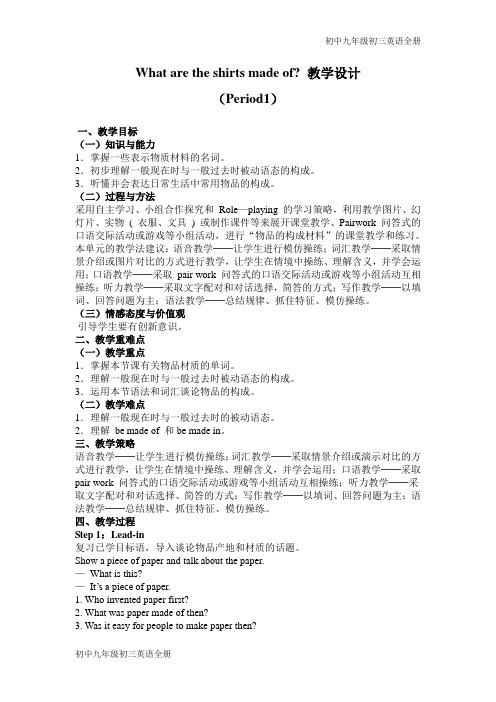
What are the shirts made of? 教学设计(Period1)一、教学目标(一)知识与能力1.掌握一些表示物质材料的名词。
2.初步理解一般现在时与一般过去时被动语态的构成。
3.听懂并会表达日常生活中常用物品的构成。
(二)过程与方法采用自主学习、小组合作探究和Role—playing 的学习策略,利用教学图片、幻灯片、实物( 衣服、文具) 或制作课件等来展开课堂教学、Pairwork 问答式的口语交际活动或游戏等小组活动,进行“物品的构成材料”的课堂教学和练习。
本单元的教学法建议:语音教学──让学生进行模仿操练;词汇教学──采取情景介绍或图片对比的方式进行教学,让学生在情境中操练、理解含义,并学会运用;口语教学──采取pair work 问答式的口语交际活动或游戏等小组活动互相操练;听力教学──采取文字配对和对话选择,简答的方式;写作教学──以填词、回答问题为主;语法教学──总结规律、抓住特征、模仿操练。
(三)情感态度与价值观引导学生要有创新意识。
二、教学重难点(一)教学重点1.掌握本节课有关物品材质的单词。
2.理解一般现在时与一般过去时被动语态的构成。
3.运用本节语法和词汇谈论物品的构成。
(二)教学难点1.理解一般现在时与一般过去时的被动语态。
2.理解be made of 和be made in。
三、教学策略语音教学──让学生进行模仿操练;词汇教学──采取情景介绍或演示对比的方式进行教学,让学生在情境中操练、理解含义,并学会运用;口语教学──采取pair work 问答式的口语交际活动或游戏等小组活动互相操练;听力教学──采取文字配对和对话选择、简答的方式;写作教学──以填词、回答问题为主;语法教学──总结规律、抓住特征、模仿操练。
四、教学过程Step 1:Lead-in复习已学目标语,导入谈论物品产地和材质的话题。
Show a piece of paper and talk about the paper.—What is this?—It’s a piece of paper.1. Who invented paper first?2. What was paper made of then?3. Was it easy for people to make paper then?4. What’s paper made of today?Now, look at the picture. This is a tower. It is made of paper.通过图片展示和对话引导学生了解物品材质的话题。
英语人教版九年级上册Unit5全单元教案
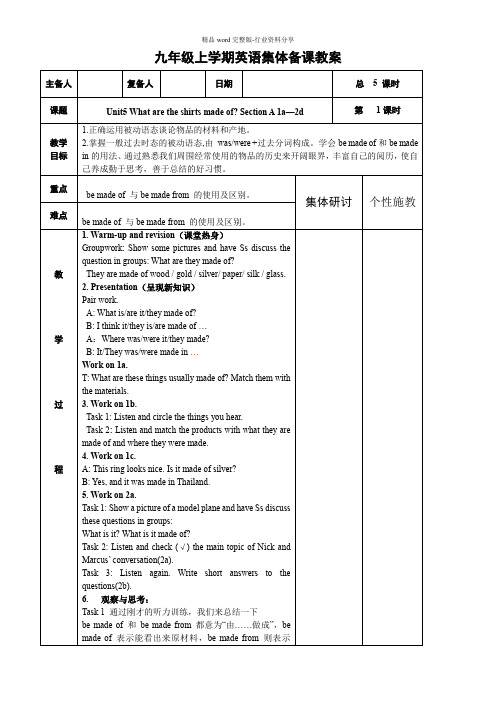
Read the sentences in Grammar Focus.Learn them by heart and translate the conversations with Ke Nan.
They are made ofwood / gold / silver/ paper/ silk/ glass.
2. Presentation(呈现新知识)
Pairwork.
A: What is/are it/they made of?
B: I think it/they is/are made of…
be made of和be made from都意为“由……做成”,be made of表示能看出来原材料,be made from则表示_____________.
练习:翻译句子
(1)桌子是由木头做成的。______________________________
(2)纸是由木头做成的。_________________________________
教
学
过
程
教
学
过
程
1. Warm-up and revision(课堂热身和复习)
(1)Pairwork两人一组讨论一下同学们的衣着服饰和学习用品。可以借鉴下面的对话:
A:What’s your pencil made of? B: It’s made of wood.
A: Where was it made? B: It was made in Shanghai.
二、熟练掌握被动语态用法,学会用被动语态表达自己喜欢的事物的认识和看法。
三、提倡学生使用国货,培养学生的爱国主义情怀。
2017-2018最新人教版初中初三九年级英语第五单元unit5教学设计(5页)备课教案教学设计教学反思导学案
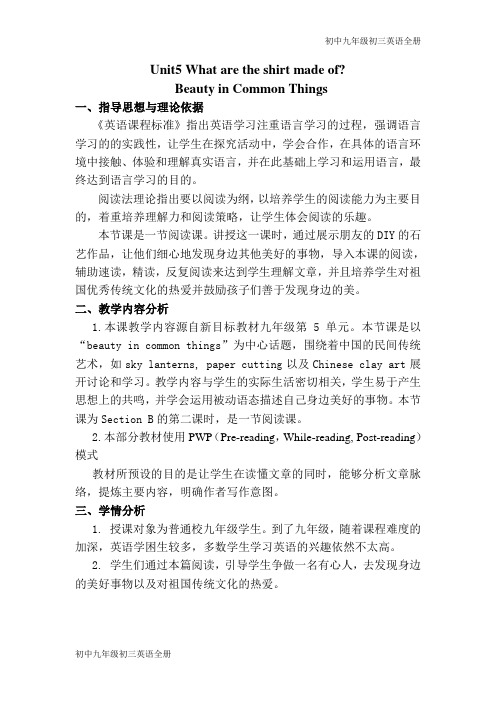
Unit5 What are the shirt made of?Beauty in Common Things一、指导思想与理论依据《英语课程标准》指出英语学习注重语言学习的过程,强调语言学习的的实践性,让学生在探究活动中,学会合作,在具体的语言环境中接触、体验和理解真实语言,并在此基础上学习和运用语言,最终达到语言学习的目的。
阅读法理论指出要以阅读为纲,以培养学生的阅读能力为主要目的,着重培养理解力和阅读策略,让学生体会阅读的乐趣。
本节课是一节阅读课。
讲授这一课时,通过展示朋友的DIY的石艺作品,让他们细心地发现身边其他美好的事物,导入本课的阅读,辅助速读,精读,反复阅读来达到学生理解文章,并且培养学生对祖国优秀传统文化的热爱并鼓励孩子们善于发现身边的美。
二、教学内容分析1.本课教学内容源自新目标教材九年级第5单元。
本节课是以“beauty in common things”为中心话题,围绕着中国的民间传统艺术,如sky lanterns, paper cutting以及Chinese clay art展开讨论和学习。
教学内容与学生的实际生活密切相关,学生易于产生思想上的共鸣,并学会运用被动语态描述自己身边美好的事物。
本节课为Section B的第二课时,是一节阅读课。
2.本部分教材使用PWP(Pre-reading,While-reading, Post-reading)模式教材所预设的目的是让学生在读懂文章的同时,能够分析文章脉络,提炼主要内容,明确作者写作意图。
三、学情分析1. 授课对象为普通校九年级学生。
到了九年级,随着课程难度的加深,英语学困生较多,多数学生学习英语的兴趣依然不太高。
2. 学生们通过本篇阅读,引导学生争做一名有心人,去发现身边的美好事物以及对祖国传统文化的热爱。
3. 学生已有的知识水平:学生们本单元已经学过被动语态,对于be made并不陌生,学生已经可以使用被动语态来表达自己的观点;九年级的学生已掌握了一定阅读的基本技能,有一定的词汇基础。
英语人教版九年级全册第五单元教学设计

③阅读第4段完成下列阅读任务
1. Where are the characters of Chinese art clay from?
2.根据文中的一段话,归纳出其主要意思:
The pieces are carefully shaped by hand from a very special kind of clay and then allowed to air-dry. After drying, they are fired at a very high heat. They are then polished and painted.
④再次通读全文,完成下列表格。
Traditional art form
Materials used
Para. 2
Sky lanterns
Para.3
Paper cutting
Para. 4
Chinese clay out
7.讨论
①找出生活中其他的传统艺术形式
②你认为如今,有些传统的艺术形式在年轻人中间流行吗?
C. Beauty hid in Chinese traditional art forms
6.精读
①阅读第1--2段完成下列阅读任务
(Para 1)
What do traditional Chinese art forms try to show?
(Para 2)
1. In the past, sky lanterns were used bytowhen in trouble.
教学
人教版英语初三Unit-5-讲义设计.docx
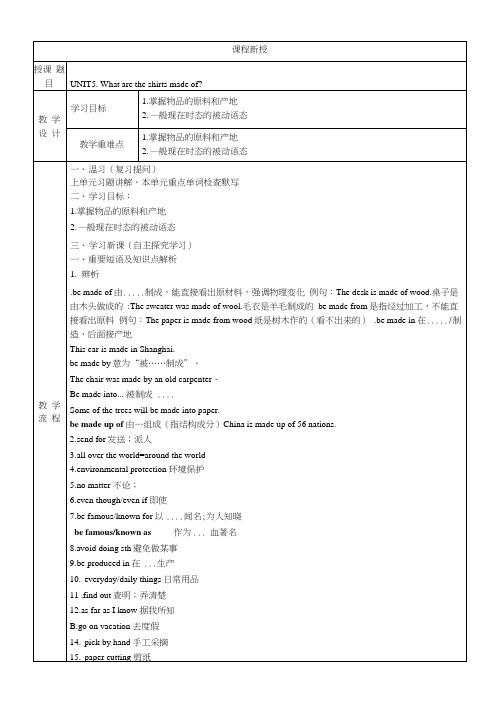
课程新授授课题目UNIT5. What are the shirts made of?教学设计学习目标1.掌握物品的原料和产地2.—般现在时态的被动语态教学重难点1.掌握物品的原料和产地2.—般现在时态的被动语态教学流程一、温习(复习提问)上单元习题讲解。
本单元重点单词检查默写二、学习目标:1.掌握物品的原料和产地2.—般现在时态的被动语态三、学习新课(自主探究学习)一、重要短语及知识点解析1.辨析.be made of由.....制成,能直接看出原材料,强调物理变化例句:The desk is made of wood.桌子是由木头做成的:The sweater was made of wool.毛衣是羊毛制成的be made from是指经过加工,不能直接看出原料例句:The paper is made from wood纸是树木作的(看不出来的).be made in在...../制造,后面接产地This car is made in Shanghai.be made by意为“被……制成”。
The chair was made by an old carpenter・Be made into... 被制成 ....Some of the trees will be made into paper.be made up of 由…组成(指结构成分)China is made up of 56 nations.2.s end for发送;派人3.a ll over the world=around the world4.e nvironmental protection 环境保护5.n o matter 不论;6.e ven though/even if 即使7.b e famous/known for以.... 闻名;为人知晓be famous/known as 作为... 血著名8.avoid doing sth避免做某事9.b e produced in 在... 生产10.everyday/daily things 日常用品11 .find out查明;弄清楚12.as far as I know 据我所知B.go on vacation 去度假14.pick by hand 手工采摘15.paper cutting 剪纸17.turn... into 把变成....18.send out发出;放出;发送19.be covered with 被.. 覆盖20.rise into ±升到;升入21.put on张贴/穿上外套22.as symbols of作为的象征23.fairy tale童话故事24.be used for/by /as 被用于....25・辨析everyday/every day(l)You can find that the sentence is widely used in our _______________ l ife・(2)David's father takes exercise ______________ .26.辨析be good for对,,有好处be good at 擅长于=do well inbe good with与... 和睦相处Drinking milk every day is _________ your health・A. good toB. good withC. good for D・ good at27.no matter what"无论什么"=whateverno matter who"无论谁,'=whoeverno matter how"无论如何^= however28.be covered with 被…覆盖29.glass n.作玻璃讲时,为不可数名词。
- 1、下载文档前请自行甄别文档内容的完整性,平台不提供额外的编辑、内容补充、找答案等附加服务。
- 2、"仅部分预览"的文档,不可在线预览部分如存在完整性等问题,可反馈申请退款(可完整预览的文档不适用该条件!)。
- 3、如文档侵犯您的权益,请联系客服反馈,我们会尽快为您处理(人工客服工作时间:9:00-18:30)。
Unit 5 What are the shirts made of?Section A 1 (1a-2d)一、教学目标:1. 语言知识目标:1) 能掌握以下单词:chopsticks, coin, fork, blouse, silver, glass, cotton, steel, grass,leaf, produce, widely, be known for, process, pack 能掌握以下句型:①—This ring looks nice. Is it made of silver?—Yes, and it was made in Thailand.②What is it made of/from?③China is famous for tea, right?④Where is tea produced in China?2) 能够用英语描述及询问物品的制作材料,正确理解被动语态的用法及句子结构。
2. 情感态度价值观目标:了解一些日常用品的制成材料,增加生活常识,养成良好的生活习惯;了解一些地方知名产品或传统艺术品的制作过程以及制作材料,培养学生的民族自豪感及爱国主义精神。
二、教学重难点1. 教学重点:1) 掌握本课时中出现的生词2) 能够用英语描述及询问物品的制作材料3)正确理解被动语态的用法及句子结构。
2. 教学难点:理解被动语态的用法及句子结构。
三、教学过程Ⅰ. Lead in1. 播放动画片《造纸过程》的视频,让学生们了解这个中国传统发明的情况。
T: Who invented paper first?S1: Can Lun invented it in Han dynasty.T: What was paper made of then?S2: It was mainly made of bamboo.T: was it easy for people to make paper then?S1: No, it was very difficult then.T: What is paper made of now?S3: It’s mainly made of wood, bamboo, and cotton.…Ⅱ. Presentation1. Present the sentence structure, using the pictures on the big screen:—What’s the golden medal made of?—It’s made of gold.—Is this table made of wood?—No, it isn’t. It’s made of glass.—Is Butter made from meat?—No. It’s made from cream?让学生们学习掌握be made of/from句型的用法,及be made of与be made from的区别。
两词组都是“由……制成的”之意。
be made of 指从原料到制成品只发生了形状变化,没有发生本质变化(属物理变化)be made from指从原料到制成品发生了质的变化,已无法复原(属化学变化)。
Ⅲ. Learning1. Show some pictures on the big screen. Try to learn the new words using “be made of”structure.Learn the new words: chopsticks, coin, fork, blouse, silver, glass, cotton, steel, grass, leafe.g. This pair of chopsticks are made of bamboo.This coin is made of silver.Is this blouse made of cotton?No, it isn’t. It’s made o f silk.What’s the fork made of?It’s made of steel.These pigs like grass very much.a piece of leafKolas like leaves.2. Ss discuss with their partner and try to learn the new words.3. Give Ss five more minutes to remember the new words.Work on 1a:Let Ss read the things and materials in 1a. Discuss with their partners and match them with the materials. More than one answer is possible.What are these things usually made of? Match them with the materials. More than one answer is possible.1.chopsticks2.window3.coin4.stamp5.fork6.blousea.woodb.goldc.silverd.papere.silkf.glassCheck the answers with the Ss.Ⅳ. Listening1.T: Tell Ss they will hear a conversation about some things and material. Listen and match the products with what they are made of and where they were made.2. Let one student read the words in the box, Play the recording for the Ss to listen.3. Ss try to listen and match the things with the material and here they were made.4. Play the recording again. Let Ss check the facts they hear.5. Check the answersⅤ. Pair work1. Read the conversation in the box in 1c.2. Ss try to made conversations using the information in 1b.e.g. A: Your new shirt looks very nice. Is it made of cotton?B: No, it isn’t. It’s made of silk.3. Let some pairs read out their conversations.Ⅵ. ListeningWork on 2a:T: Let’s listen to another conversation between Nick and Marcus.1. What are they talking about? First, let’s look at the pictures and the phrases in 1a.(Let one students read the phrases in 2a.)Listen and check ( √) the main topic of Nick and Marcus’ conversation.____ the science museum____ the art and science fair____ environmental protection____ a model plane____ a beautiful painting____ grass and leaves2. Play the recording for the Ss to listen and check the phrases.3. Play the recording again to check the answers.Work on 2b:1. Let Ss read the sentences below. Explain some main sentences for the Ss. Make sure they know what to do.2. Let Ss read the questions in 2b. Make sure they understand the meaning of each question.Play the recording for the Ss to answer the questions. (If necessary, using the pause button.)1) Where is the art and science fair?_________________________2) Do Nick and Marcus have to pay to go?_________________________3) What is the model plane made of?_________________________4) What is the painting made from?__________________________3. Play the recording again to check the answers.4. Play the recording again. Let Ss fill in the blanks of the conversation.Ⅶ. Pair work1. Tell Ss to make a conversation using the information in 2a and 2b.e.g.A: What did you see at the art and science fair?B: I saw a model plane.A: What is it made of?B: It’s made of steel, glass, and plastic.2. Let Ss make their own conversations.3. Practice their conversations in pairs.Ⅷ. Role-play1. Work on 2dRead the conversation and complete the blanks.1) Chinese _____________ tea both in the past and now.2) _________ I know, tea plants _________ on the sides of mountains.3) When the leaves are ready, they _______ by hand and then _______ for processing.4) The tea ____________ and sent to many different countries and places around China.5) People say that tea ___________ ____ health _____ business!2. Read the conversations and Let Ss read after the teacher.3. Explain some new words and main points in the conversation.4. Ask Ss to role-play the conversation in groups.X. Language points1. What is the model plane made of?What is the painting made from?be made of与be made from 辨析两词组都是“由……制成的”之意。
